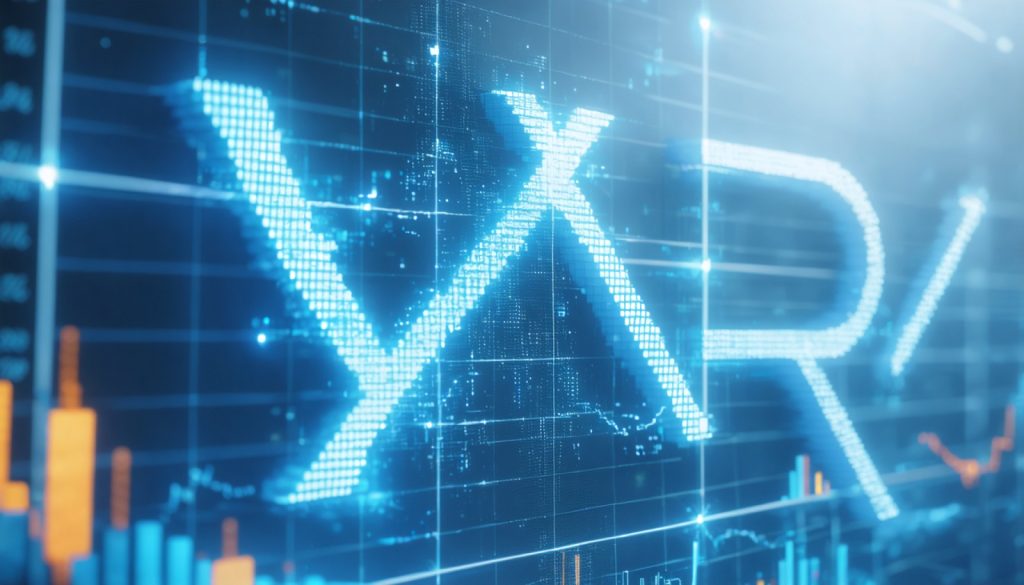
- Ripple’s XRP aims to revolutionize global money transfers by challenging the established SWIFT system with its faster and cheaper blockchain technology.
- Despite a 10% recent price drop, XRP achieved a remarkable 200% increase in 2024, highlighting its volatility and continued investor interest.
- Key metrics for XRP investors include the number of payments between accounts and total transaction volumes, which reveal contrasting trends in adoption and usage.
- Increased payment frequency suggests growing interest in XRP, but declining transaction volumes indicate challenges in institutional adoption.
- Integrating Ripple’s solution into the entrenched banking infrastructure remains a significant challenge, crucial for its success against SWIFT’s dominance.
- Investors are encouraged to closely monitor these metrics, as Ripple’s potential rewards could reshape global finance despite existing skepticism.
- XRP’s transformative promise requires patience from investors willing to embrace the long-term potential of untapped innovation.
Ripple’s cryptocurrency, XRP, has captured investors’ imaginations with its ambitious vision to revolutionize global money transfers, but the recent 10% drop in its price has rattled even the most steadfast holders. Despite this decline, 2024 marked a record-breaking year for XRP, boasting a staggering 200% increase. Such volatile swings leave investors questioning: what truly lies ahead for this digital asset as we venture deeper into 2025?
At the heart of Ripple’s mission is its promise to transform cross-border payments, challenging the decades-old SWIFT system. Since its inception in 1973, SWIFT has been the cornerstone of international transactions for financial institutions worldwide. Ripple offers a tantalizing alternative: blockchain-based technology that promises to make global transfers faster, cheaper, and more transparent. Yet, integrating a new system into the entrenched infrastructure of global banks remains a Herculean task.
For those eyeing XRP’s potential, two vital metrics demand close examination: the count of payments between XRP accounts and the total transaction volumes processed across its network. While the number of payments paints a picture of growing adoption, the more telling metric—total transaction volumes—shows a surprisingly downward trend.
These metrics unveil a dual narrative. On one hand, individual payment frequency suggests heightened interest and activity in XRP utilization. However, dwindling transaction volumes signal potential hurdles in widespread institutional adoption. Such insights offer a complex view of Ripple’s battle against SWIFT’s long-standing dominance.
For Ripple to succeed, it’s not merely about increasing user participation but achieving significant traction in transaction volumes, reflecting true integration into the financial fabric of global commerce. Skepticism remains, but the colossal upside potential continues to entice those with a long-term vision.
As investors ponder XRP’s destiny, the key takeaway remains clear: observe these hidden signals with vigilance. While murky waters swirl around the cryptocurrency, the promise of transformation remains its most alluring beacon. Ripple’s ambitious journey demands patience, but for those willing to stake their future on untapped innovation, the rewards could redefine the landscape of global finance.
Is Ripple (XRP) Set to Transform Global Financial Transactions?
Ripple’s Opportunity and Challenge
Ripple’s cryptocurrency, XRP, continues to capture the imagination of investors with its audacious goal to revamp global money transfers. Despite a recent 10% drop in its price, 2024 marked a transformative year with a 200% increase. The journey ahead as we enter 2025 is fraught with both opportunity and challenge—questions abound about what truly lies ahead for XRP and Ripple’s broader mission.
Understanding Ripple’s Potential
Ripple aims to revolutionize the way financial institutions conduct cross-border payments by challenging the incumbent SWIFT system. SWIFT, established in 1973, has long been the backbone of international financial transactions. Ripple’s blockchain-based technology offers a compelling alternative that promises faster, cheaper, and more transparent transfers.
Key Metrics to Watch
Two crucial metrics provide insight into Ripple’s progress:
1. Number of Payments Between XRP Accounts: This metric reflects growing interest and adoption as more individuals and organizations experiment with XRP for transactions.
2. Total Transaction Volumes Across Ripple’s Network: While the number of individual payments is rising, total transaction volumes have shown a downward trend, indicating challenges in reaching a broader institutional audience.
Future Prospects and Insights
Market Forecasts & Industry Trends
– Continued Growth in Blockchain Adoption: The global blockchain market is expected to continue growing, with financial services being a primary area of expansion. Ripple’s technology could benefit from this trend if it can prove its reliability and efficiency over traditional systems like SWIFT.
– Increased Regulatory Scrutiny: As Ripple gains traction, it will face increased regulatory scrutiny. Building a collaborative approach with financial regulators will be crucial to its long-term success.
Real-World Use Cases
– Cross-Border Remittances: Ripple’s technology could drastically reduce the time and cost of sending remittances across borders, benefiting millions globally.
– Institutional Settlements: Some financial institutions are already piloting Ripple’s technology to improve settlement times and reduce operational costs. Successful pilots could improve confidence in Ripple’s systems.
Controversies & Limitations
– Volatility and Speculation: Like other cryptocurrencies, XRP is subject to high volatility. This characteristic can deter conservative investors and institutional adoption.
– Integration Challenges: Incorporating new technology into entrenched financial infrastructures is complex, requiring time, money, and adaptability from institutions.
Security & Sustainability
– Energy Efficiency: Compared to other blockchains, Ripple’s consensus algorithm is more energy-efficient, making it an attractive option as the world becomes increasingly conscious of sustainability.
User Recommendations
For those interested in investing in or utilizing Ripple’s technology:
– Stay Informed: Continuously monitor Ripple’s partnerships and network updates. The evolution of these factors will indicate the company’s future success.
– Diversify Investments: Given the inherent volatility in cryptocurrencies, consider diversifying your portfolio to manage risks.
– Understand the Technology: Before investing heavily, ensure you understand how Ripple’s technology works and its potential implications in the financial world.
Conclusion
Ripple’s journey embodies both promise and peril. As it navigates the choppy waters of global finance, the company faces challenges in scaling its adoption while maintaining stability. However, for those with a long-term vision, the potential rewards are substantial.
For more information on financial innovations and cryptocurrency insights, check resources like Investopedia or explore CoinDesk.



